Abstract
1. To determine if negative upper airway pressure causes reflex pharyngeal dilator muscle activation, we used intra-oral bipolar surface electrodes to record genioglossus electromyogram (EMG) activity in response to 500 ms duration pressure stimuli of 0, -2.5, -5, -15, -25 and -35 cm H2O (0-90% rise time less than 30 ms) in ten normal, conscious, supine subjects. 2. With the subjects relaxed at end-expiration, stimuli were applied in each of three conditions: (i) glottis open (GO), (ii) glottis closed (GC) and (iii) controls with the mouth and nose closed. 3. Six rectified and integrated EMG responses were bin averaged for each pressure in each experimental condition. Response latency was defined as the time when the EMG activity significantly increased above pre-stimulus levels. Response magnitude was quantified as the ratio of the EMG activity for 80 ms post-stimulus to 80 ms prestimulus; data from after the subject's voluntary reaction time (for tongue protrusion) were not analysed. 4. Negative airway pressure activated the genioglossus. The median latency of activation (34 ms) was much faster than the time for voluntary activation (184 ms) indicating a reflex response. 5. Significant activation, compared to 0 cmH2O controls and controls with mouth and nose closed, occurred with pressures of at least -5 cm H2O (GC) and -15 cm H2O (GO). At -25 and -35 cm H2O, responses with GO were significantly greater than with GC. 6. The magnitude ('strength') of the responses differed between subjects; these differences were repeatable. 7. We conclude that negative airway pressure causes reflex pharyngeal dilator muscle activation in man. Responses with GC suggest that upper airway receptors can mediate the response but larger responses with GO indicate a contribution from subglottal receptors.
Full text
PDF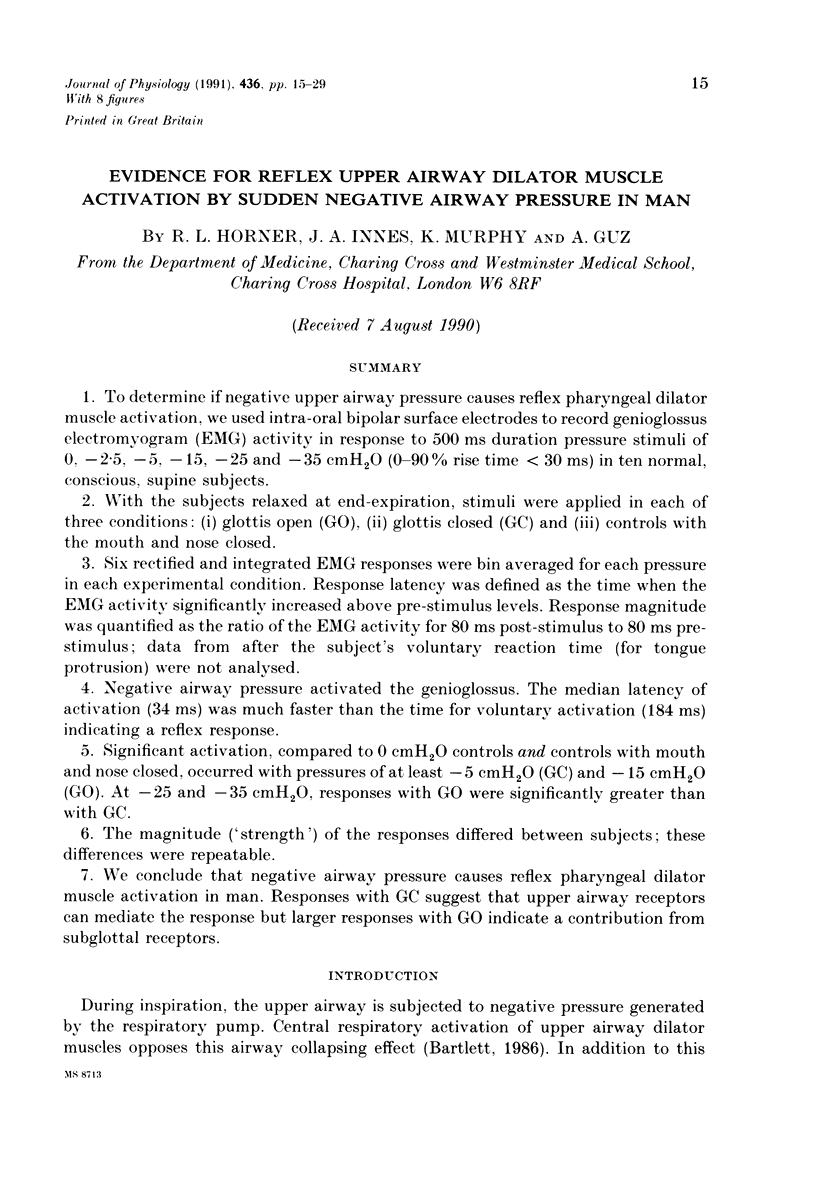
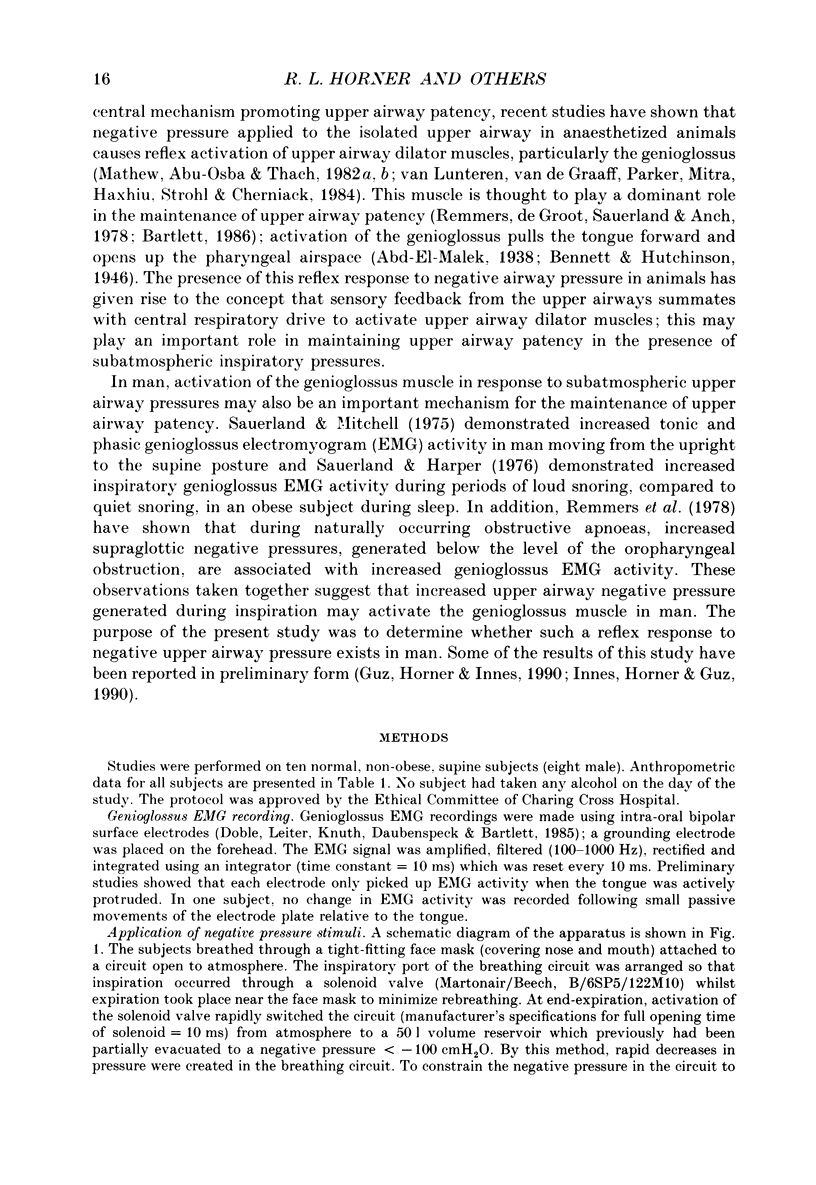
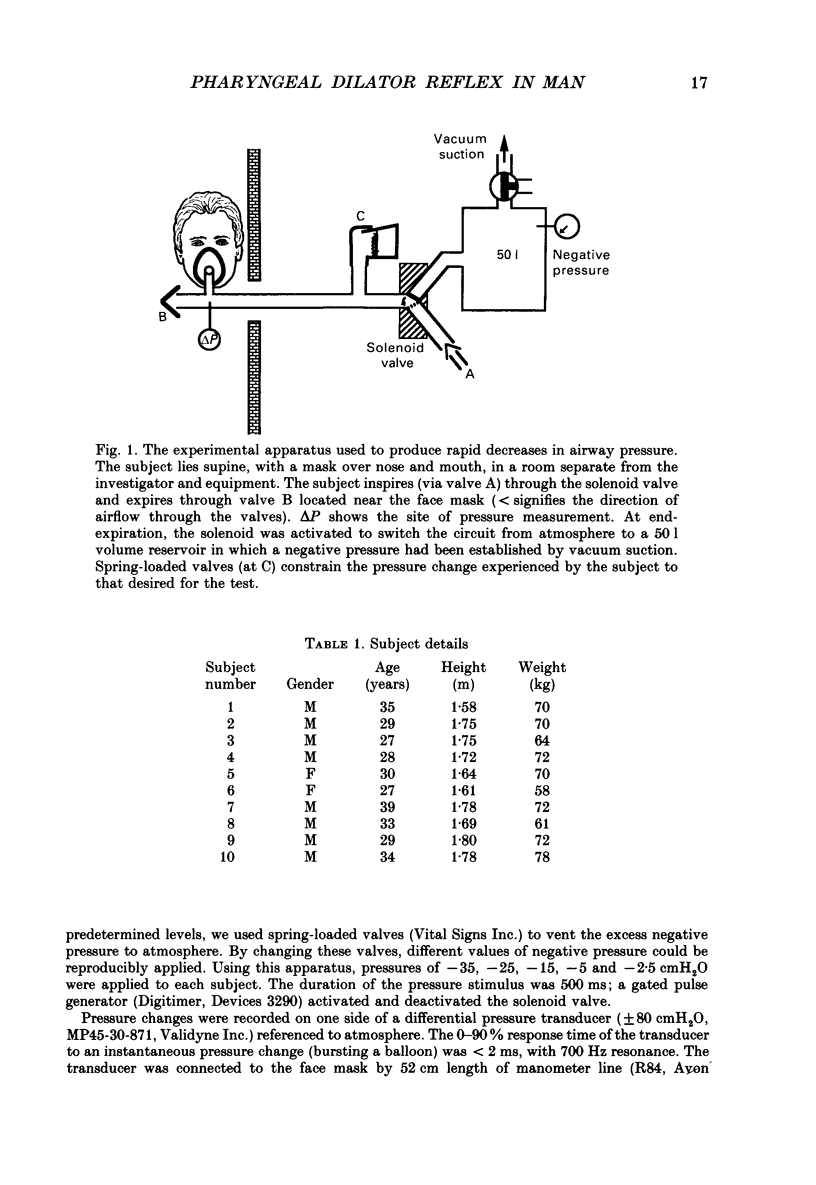
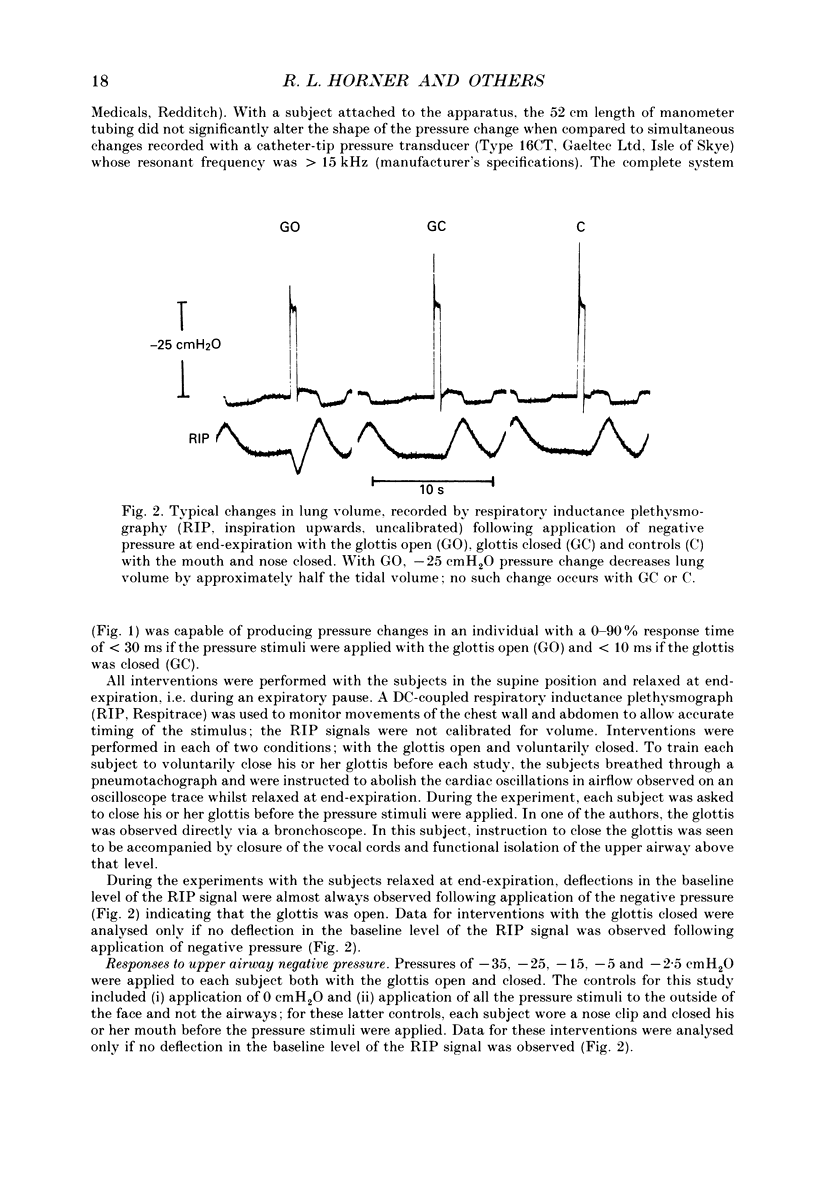
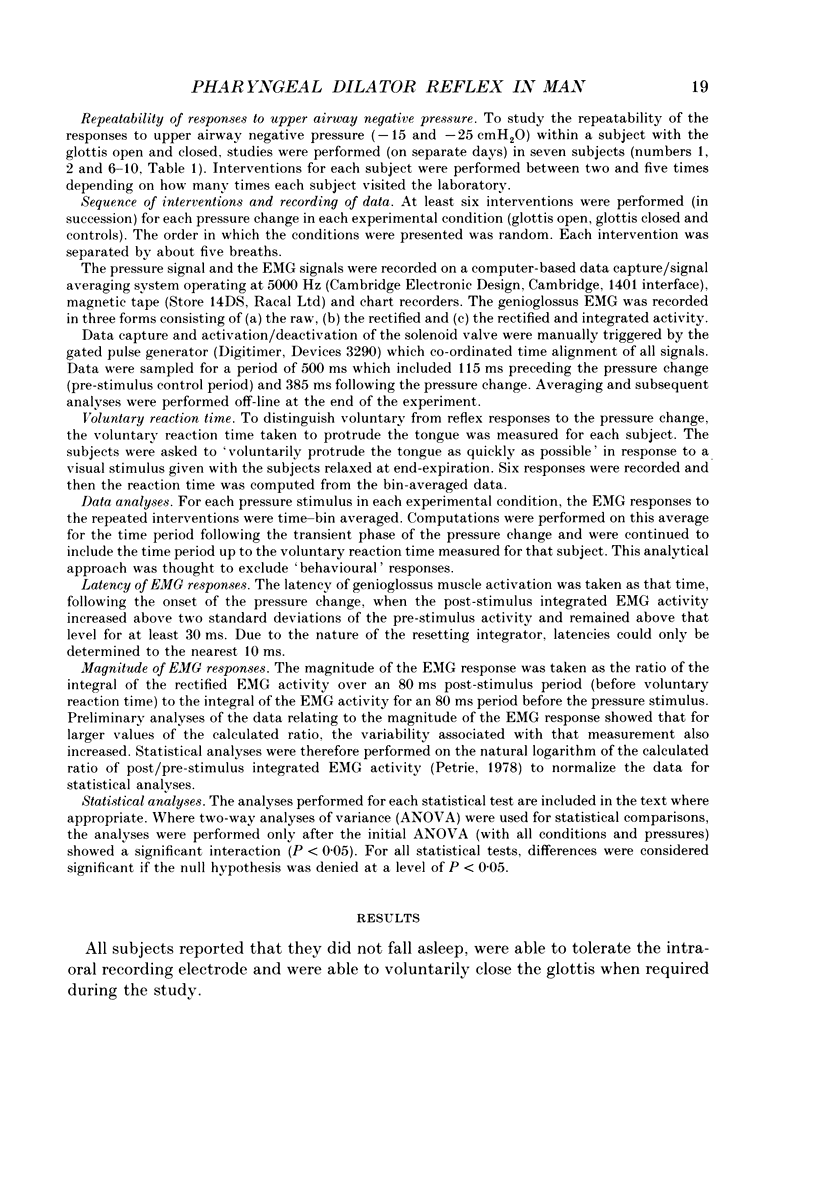
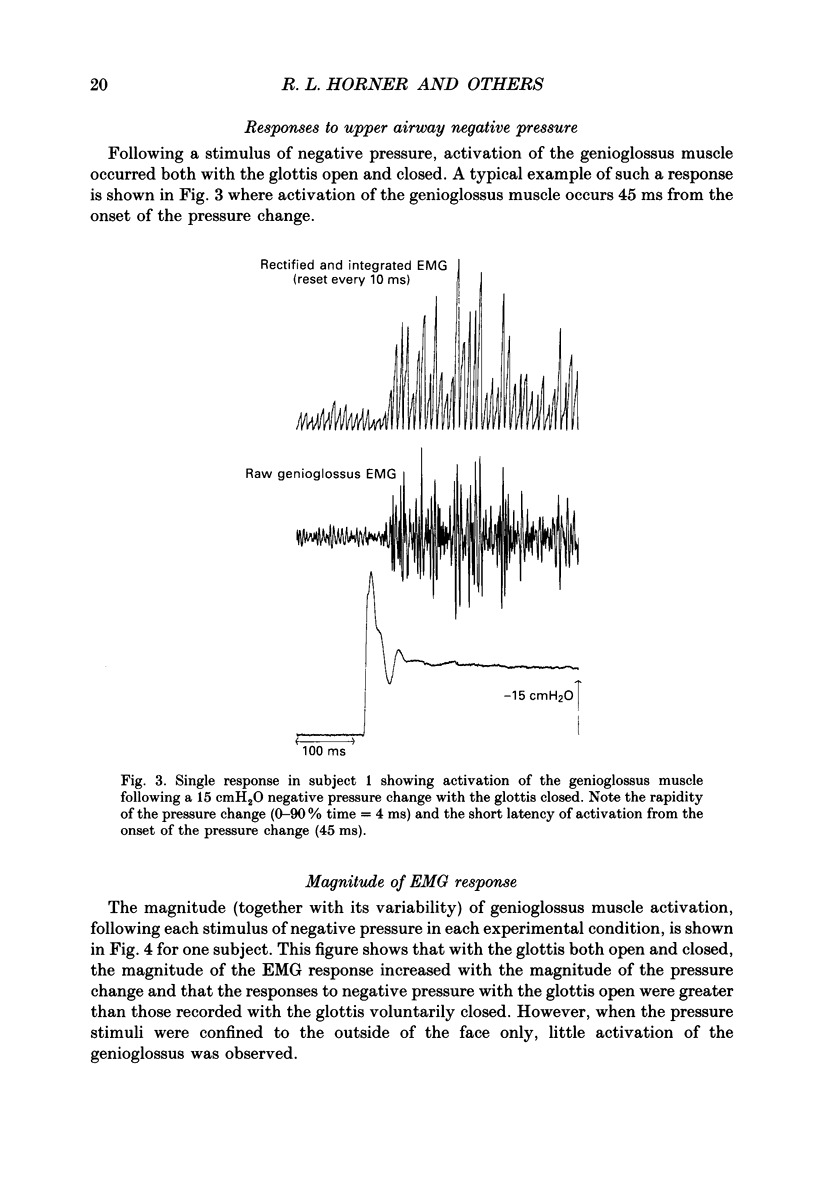
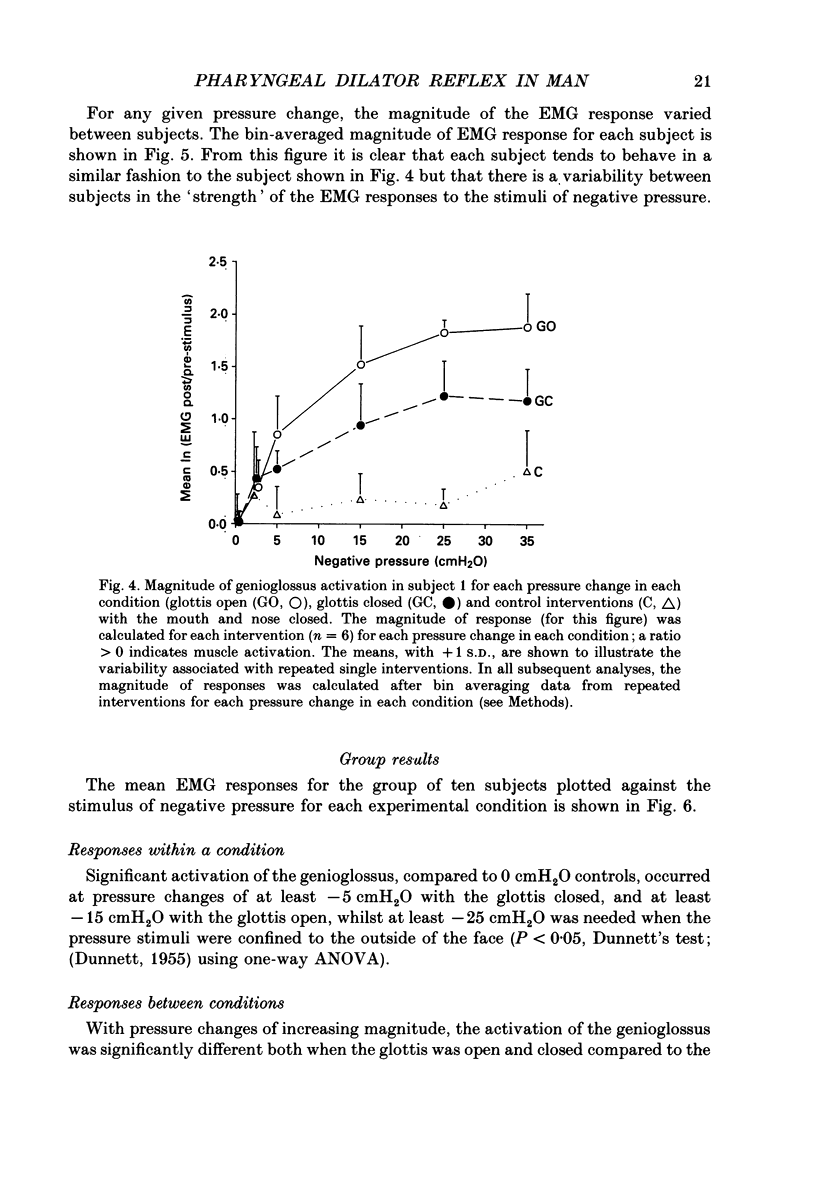
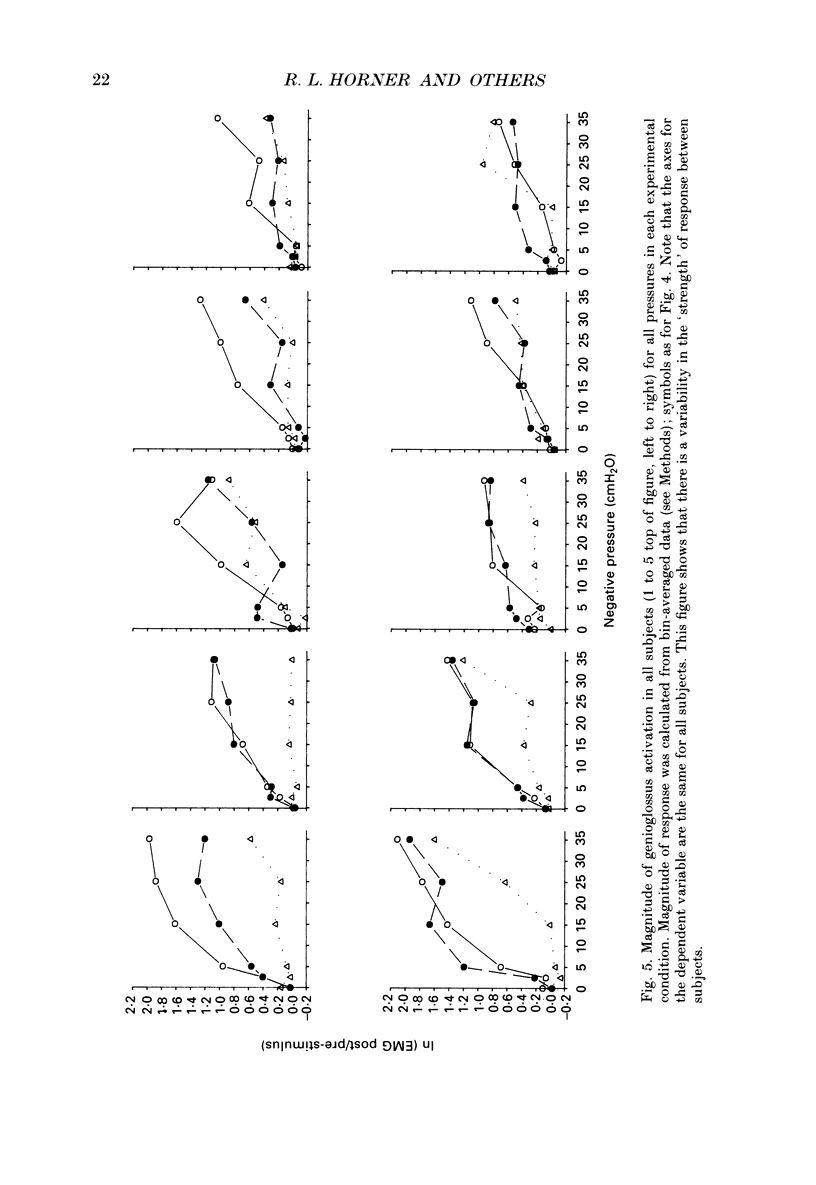

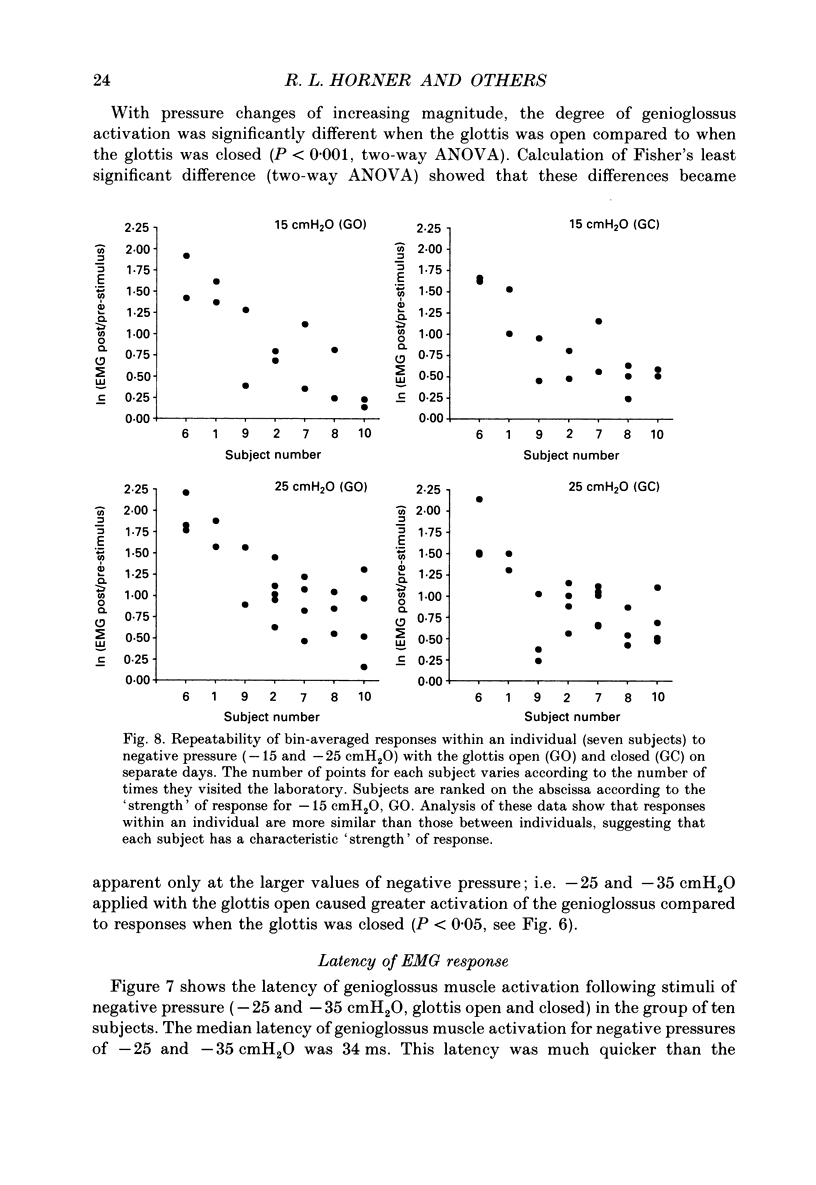
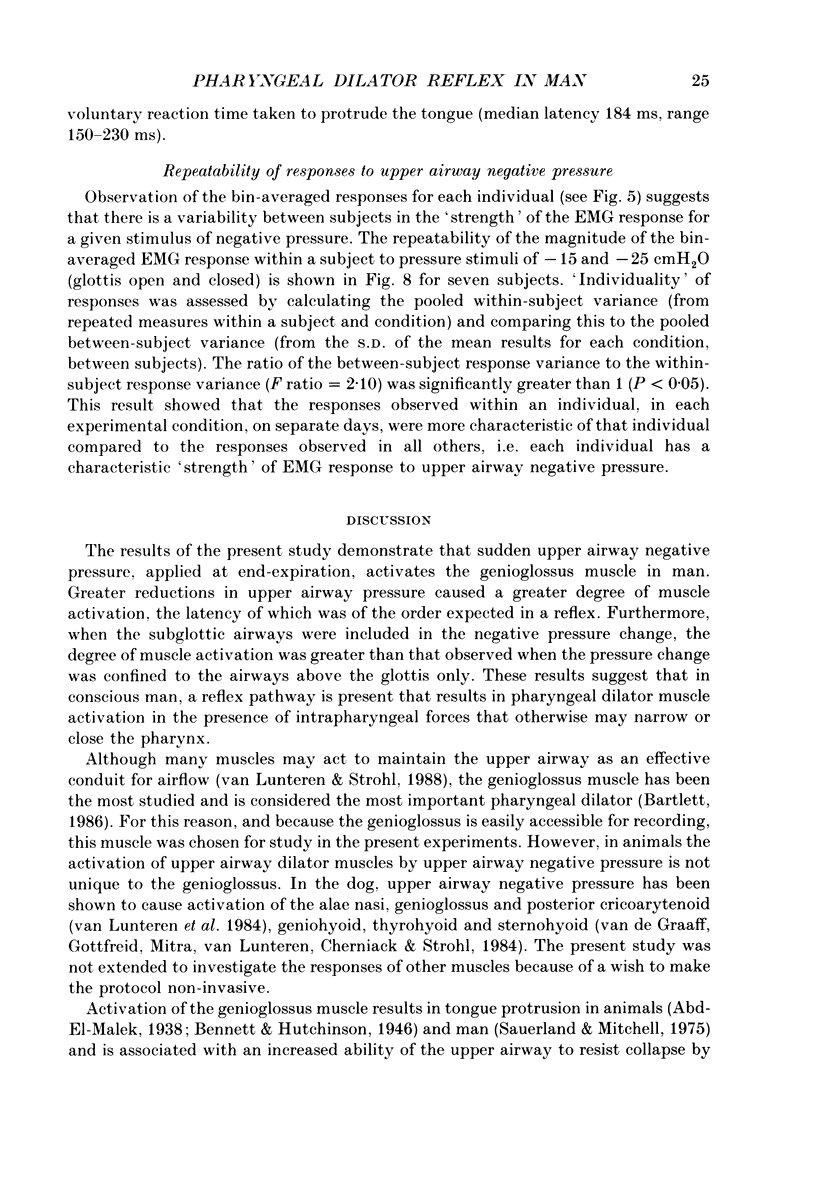
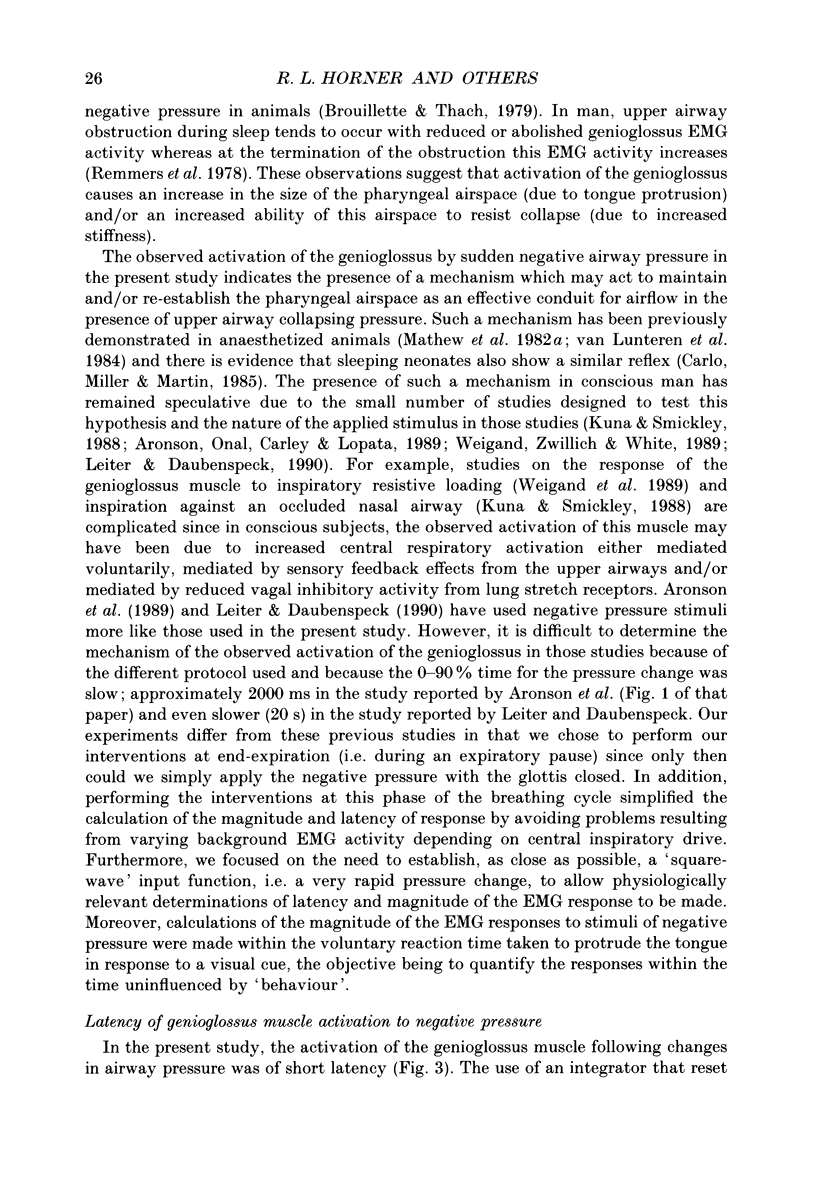
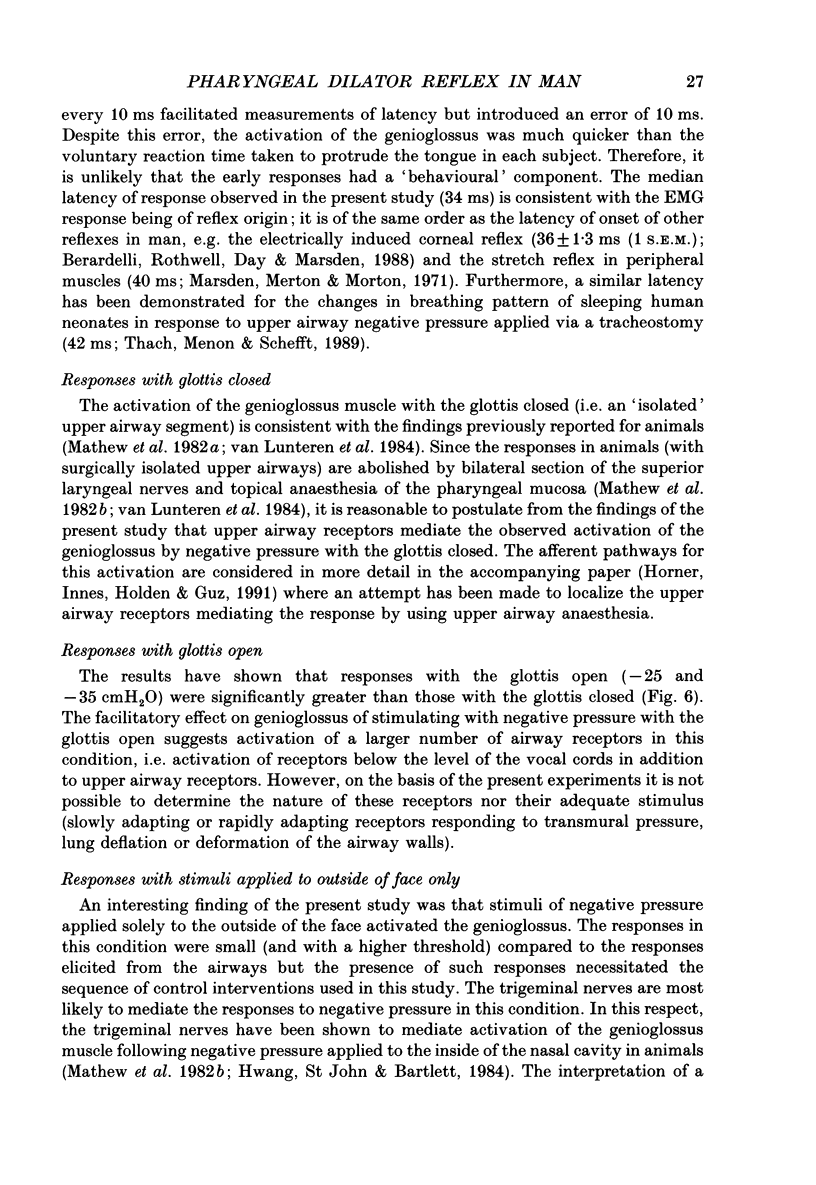
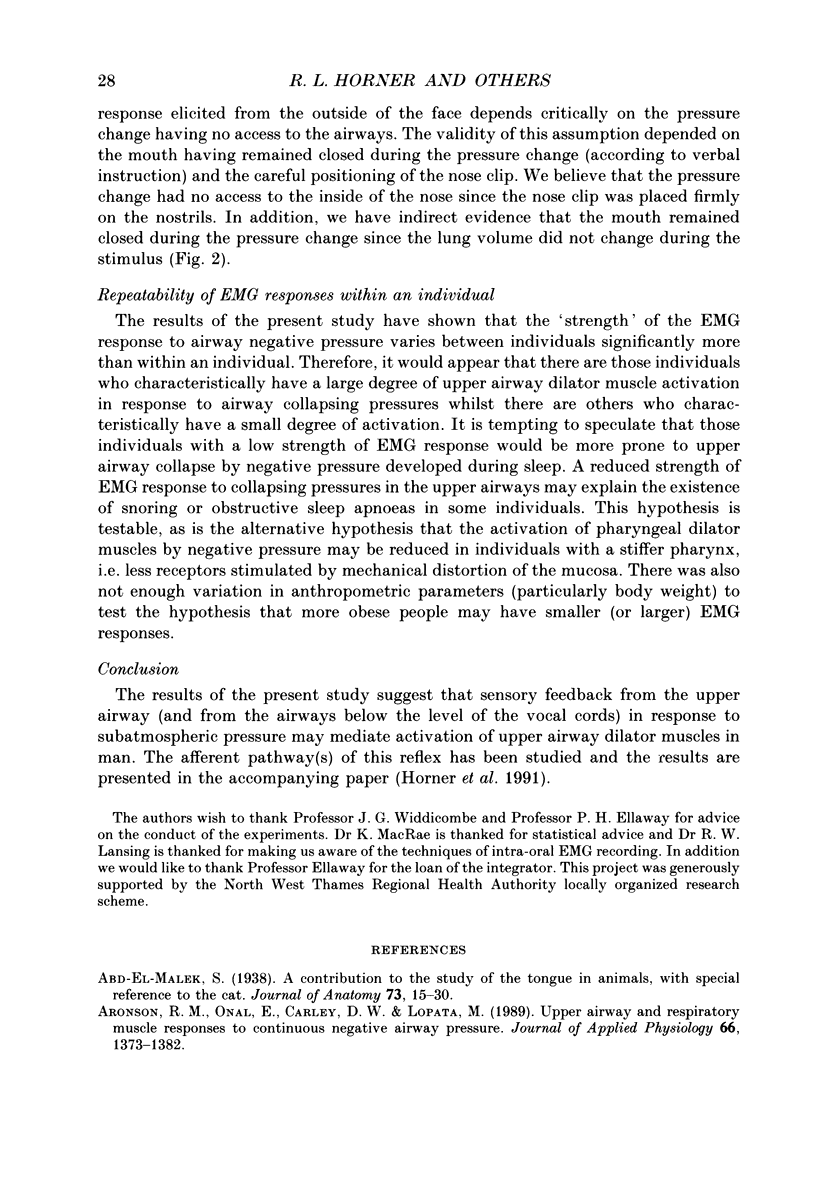
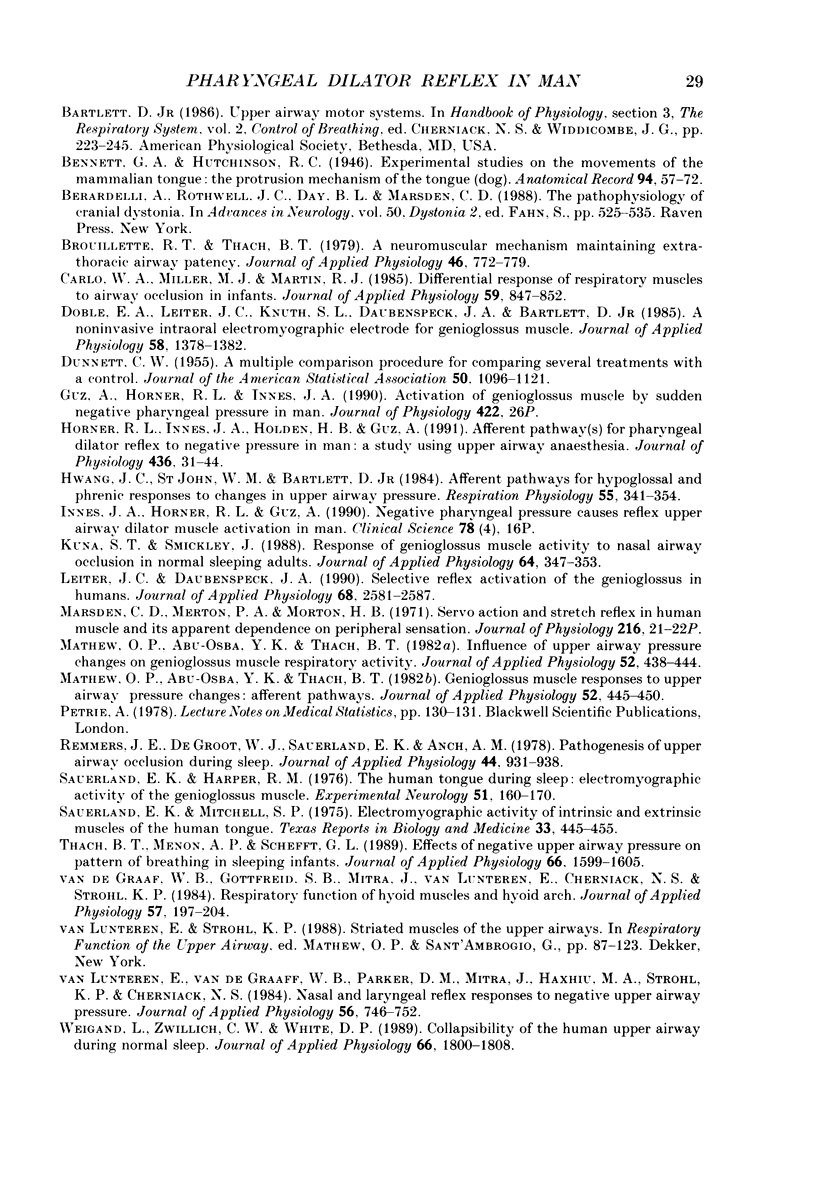
Selected References
These references are in PubMed. This may not be the complete list of references from this article.
- Abd-El-Malek S. A contribution to the study of the movements of the tongue in animals, with special reference to the cat. J Anat. 1938 Oct;73(Pt 1):15–30.1. [PMC free article] [PubMed] [Google Scholar]
- Aronson R. M., Onal E., Carley D. W., Lopata M. Upper airway and respiratory muscle responses to continuous negative airway pressure. J Appl Physiol (1985) 1989 Mar;66(3):1373–1382. doi: 10.1152/jappl.1989.66.3.1373. [DOI] [PubMed] [Google Scholar]
- Berardelli A., Rothwell J. C., Day B. L., Marsden C. D. The pathophysiology of cranial dystonia. Adv Neurol. 1988;50:525–535. [PubMed] [Google Scholar]
- Brouillette R. T., Thach B. T. A neuromuscular mechanism maintaining extrathoracic airway patency. J Appl Physiol Respir Environ Exerc Physiol. 1979 Apr;46(4):772–779. doi: 10.1152/jappl.1979.46.4.772. [DOI] [PubMed] [Google Scholar]
- Carlo W. A., Miller M. J., Martin R. J. Differential response of respiratory muscles to airway occlusion in infants. J Appl Physiol (1985) 1985 Sep;59(3):847–852. doi: 10.1152/jappl.1985.59.3.847. [DOI] [PubMed] [Google Scholar]
- Doble E. A., Leiter J. C., Knuth S. L., Daubenspeck J. A., Bartlett D., Jr A noninvasive intraoral electromyographic electrode for genioglossus muscle. J Appl Physiol (1985) 1985 Apr;58(4):1378–1382. doi: 10.1152/jappl.1985.58.4.1378. [DOI] [PubMed] [Google Scholar]
- Horner R. L., Innes J. A., Holden H. B., Guz A. Afferent pathway(s) for pharyngeal dilator reflex to negative pressure in man: a study using upper airway anaesthesia. J Physiol. 1991 May;436:31–44. doi: 10.1113/jphysiol.1991.sp018537. [DOI] [PMC free article] [PubMed] [Google Scholar]
- Hwang J. C., StJohn W. M., Bartlett D., Jr Afferent pathways for hypoglossal and phrenic responses to changes in upper airway pressure. Respir Physiol. 1984 Mar;55(3):341–354. doi: 10.1016/0034-5687(84)90056-2. [DOI] [PubMed] [Google Scholar]
- Kuna S. T., Smickley J. Response of genioglossus muscle activity to nasal airway occlusion in normal sleeping adults. J Appl Physiol (1985) 1988 Jan;64(1):347–353. doi: 10.1152/jappl.1988.64.1.347. [DOI] [PubMed] [Google Scholar]
- Leiter J. C., Daubenspeck J. A. Selective reflex activation of the genioglossus in humans. J Appl Physiol (1985) 1990 Jun;68(6):2581–2587. doi: 10.1152/jappl.1990.68.6.2581. [DOI] [PubMed] [Google Scholar]
- Marsden C. D., Merton P. A., Morton H. B. Servo action and stretch reflex in human muscle and its apparent dependence on peripheral sensation. J Physiol. 1971 Jul;216(1):21P–22P. [PubMed] [Google Scholar]
- Mathew O. P., Abu-Osba Y. K., Thach B. T. Genioglossus muscle responses to upper airway pressure changes: afferent pathways. J Appl Physiol Respir Environ Exerc Physiol. 1982 Feb;52(2):445–450. doi: 10.1152/jappl.1982.52.2.445. [DOI] [PubMed] [Google Scholar]
- Mathew O. P., Abu-Osba Y. K., Thach B. T. Influence of upper airway pressure changes on genioglossus muscle respiratory activity. J Appl Physiol Respir Environ Exerc Physiol. 1982 Feb;52(2):438–444. doi: 10.1152/jappl.1982.52.2.438. [DOI] [PubMed] [Google Scholar]
- Remmers J. E., deGroot W. J., Sauerland E. K., Anch A. M. Pathogenesis of upper airway occlusion during sleep. J Appl Physiol Respir Environ Exerc Physiol. 1978 Jun;44(6):931–938. doi: 10.1152/jappl.1978.44.6.931. [DOI] [PubMed] [Google Scholar]
- Sauerland E. K., Harper R. M. The human tongue during sleep: electromyographic activity of the genioglossus muscle. Exp Neurol. 1976 Apr;51(1):160–170. doi: 10.1016/0014-4886(76)90061-3. [DOI] [PubMed] [Google Scholar]
- Thach B. T., Menon A. P., Schefft G. L. Effects of negative upper airway pressure on pattern of breathing in sleeping infants. J Appl Physiol (1985) 1989 Apr;66(4):1599–1605. doi: 10.1152/jappl.1989.66.4.1599. [DOI] [PubMed] [Google Scholar]
- Van de Graaff W. B., Gottfried S. B., Mitra J., van Lunteren E., Cherniack N. S., Strohl K. P. Respiratory function of hyoid muscles and hyoid arch. J Appl Physiol Respir Environ Exerc Physiol. 1984 Jul;57(1):197–204. doi: 10.1152/jappl.1984.57.1.197. [DOI] [PubMed] [Google Scholar]
- Wiegand L., Zwillich C. W., White D. P. Collapsibility of the human upper airway during normal sleep. J Appl Physiol (1985) 1989 Apr;66(4):1800–1808. doi: 10.1152/jappl.1989.66.4.1800. [DOI] [PubMed] [Google Scholar]
- van Lunteren E., Van de Graaff W. B., Parker D. M., Mitra J., Haxhiu M. A., Strohl K. P., Cherniack N. S. Nasal and laryngeal reflex responses to negative upper airway pressure. J Appl Physiol Respir Environ Exerc Physiol. 1984 Mar;56(3):746–752. doi: 10.1152/jappl.1984.56.3.746. [DOI] [PubMed] [Google Scholar]


